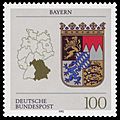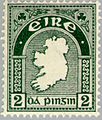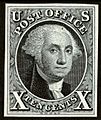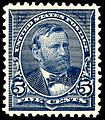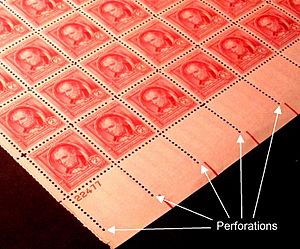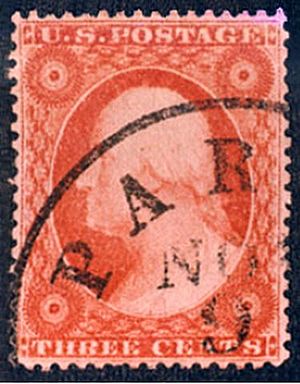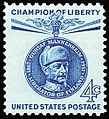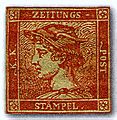Postage stamp facts for kids
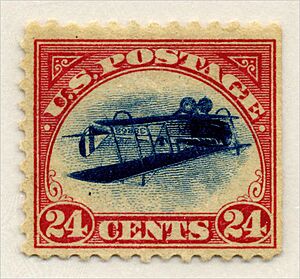
Postage stamps are small pieces of paper with glue on the back. You stick them on an envelope to show you've paid the fee for sending mail. The postal service then delivers your letter or package. There are many different postage stamps around the world. They have been used since the 19th century. Most countries have their own unique stamps. People often collect them in special books called stamp albums. Some collectors focus on stamps from one country. Others look for stamps with interesting errors, like the famous "Inverted Jenny" stamp where the airplane was printed upside down.
Contents
Maps on Stamps: A World of Art
Maps on stamps are a popular topic for stamp collecting. Almost every country has shown maps on its stamps. Some stamps feature maps of a country itself. Others show maps related to specific topics. For example, some stamps show explorer routes over maps.
- Examples of maps on stamps
-
Coat of Arms "Bayern" and Germany map
-
"Eire", 1922 Ireland
People on Stamps: Famous Faces
Stamps often feature pictures of important people. This is another common topic in stamp collecting. For example, many famous people are shown on stamps in the United States. These can include presidents, scientists, artists, and more.
- Examples of people on U.S. stamps
History of Postage Stamps

Postage stamps have helped deliver mail since the 1840s. Before stamps, people often used ink and hand-stamps. These were usually made from wood or cork. They marked the mail to show that postage had been paid.
The first sticky postage stamp was the Penny Black. It was released in the United Kingdom in 1840. The idea for stamps was part of a plan to make the postal system better. In the early 1800s, the postal system in the United Kingdom of Great Britain and Ireland was messy.
Before stamps, the person receiving the mail usually paid for it. This caused problems. Sometimes, people couldn't or wouldn't pay. Also, senders had no reason to limit how much mail they sent. Stamps solved this issue simply. They also added a touch of beauty to mail.
Sir Rowland Hill helped introduce stamps in the UK. Stamps meant the sender paid the postage fee. This happened from May 1, 1840. Even so, it was still possible to send mail without paying first. After stamps were used, postmarks were put on them. This stopped people from using the stamps again.
The "Penny Black" stamp became available on May 1, 1840. It was valid from May 6, 1840. Two days later, the Two penny blue stamp was introduced. The Penny Black was enough to send a letter less than half an ounce anywhere in the UK. Both stamps showed a picture of the young Queen Victoria. They did not have perforations (small holes) yet. People had to cut them from the sheets with scissors.
The first stamps did not need to show the country's name. So, no country name was on them. The UK is still the only country that doesn't put its name on stamps. Instead, they use the picture of the current monarch. After stamps were introduced, the number of letters sent in the UK grew a lot. Before 1839, about 76 million letters were sent. By 1850, this jumped to 350 million! This number kept growing until the late 1900s. Then, new ways of paying for postage reduced the use of stamps.
Other countries soon started using their own stamps. Switzerland's Canton of Zürich issued the Zurich 4 and 6 rappen on March 1, 1843. Brazil released the Bull’s Eye stamp on August 1, 1843. Brazil used the same printer as the Penny Black. But they chose an abstract design instead of a portrait of Emperor Pedro II. This was so his image wouldn't be damaged by a postmark.
In 1845, some postmasters in the United States issued their own stamps. But the first official U.S. stamps came out in 1847. These were 5 and 10 cent stamps showing Benjamin Franklin and George Washington. Other countries also issued stamps in the late 1840s. The famous Mauritius "Post Office" stamps came out in September 1847. Many others, like India, started using stamps in the 1850s. By the 1860s, most countries had stamps.
Perforations on stamps began in January 1854. The first official perforated stamps were issued in February 1854.
Stamp Design and Features
When the first stamps came out in the 1840s, they looked very similar. They were rectangular. They showed pictures of Queens, Presidents, or other political leaders. They also showed the value of the postage. All countries except the United Kingdom included their country's name. Most early stamps only showed national leaders.
Soon, other subjects and designs started appearing. Some designs were liked, others were criticized. For example, in 1869, the U.S. Post Office changed its tradition. Instead of presidents, they used pictures of a train and a horse. This change was not popular with the American public.
Perforations: Making Stamps Easy to Separate
Perforations are small holes made between individual stamps on a sheet. They make it easy to tear off the number of stamps you need. These holes create the wavy, rippled edge that stamps are known for.
For the first few years, stamps were made without perforations. You had to use scissors or tear them to separate them from the sheet. This was inconvenient for postal workers and businesses. They dealt with many stamps every day. By 1850, people started inventing ways to make separation easier.
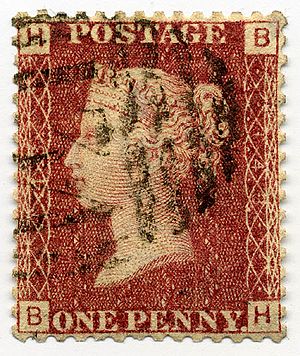
The UK was the first country to issue stamps with perforations. Henry Archer, an Irish inventor, created the first machine for perforating stamp sheets. The 1850 Penny Red was the first stamp to be perforated during trials of Archer's machine. After some improvements, new machines were bought. In 1854, the UK postal service started regularly issuing perforated stamps.
In the U.S., stamps quickly became popular. Their use grew even more when a law in 1855 required all mail to be prepaid. After this, stamp use in the U.S. doubled quickly. By 1861, it had quadrupled.
In 1856, a company called Toppan and Carpenter bought a machine to separate stamps. This machine was patented in England in 1854. It originally cut slits in the paper. But it was soon changed to punch holes.
The first U.S. stamp to be officially perforated was the 3-cent George Washington stamp. It was issued on February 24, 1857. Between 1857 and 1861, all stamps from 1851 to 1856 were reissued with perforations. At first, there weren't enough machines to perforate all stamps. So, perforated stamps from February to July 1857 are rare and valuable.
Related pages
Images for kids
-
The US Mail postage stamp of Marshal C. G. E. Mannerheim from 1961
-
The 1985 postage stamp for 115th birth anniversary of Vladimir Lenin. Portrait of Lenin (based on a 1900 photography of Y. Mebius in Moscow) with the Tampere Lenin Museum.
-
A Costa Rica Airmail stamp of 1937.
-
The Red Mercury, a rare 1856 newspaper stamp of Austria.
-
A 1987 Faroe Islands miniature sheet, in which the stamps form a part of a larger image.
See also
 In Spanish: Sello postal para niños
In Spanish: Sello postal para niños


